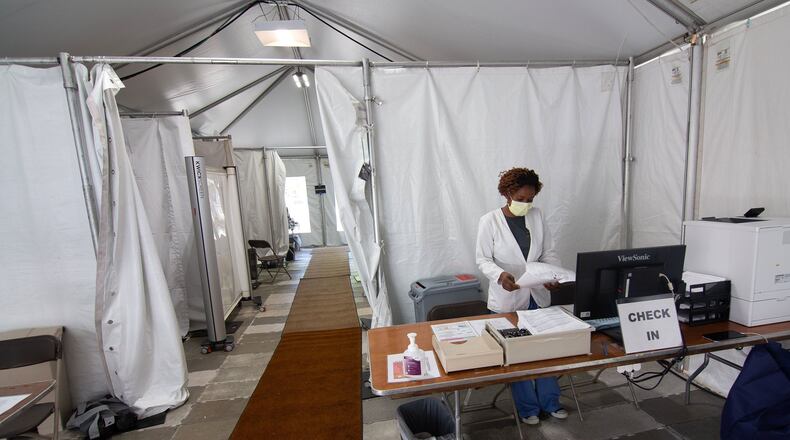Weeks before COVID-19 claimed its first Georgian, the state’s healthcare system was already showing signs of stress and crowding.
Several metro area hospitals were planning significant expansions to handle spiking patient loads, while hospitals in rural areas continued to struggle under the strain of treating uninsured patients amid the closure of seven rural hospitals in recent years. In December, Atlanta hospitals faced an unexpected surge in patients from Grady Memorial Hospital after flooding from a broken water pipe forced the shutdown of three floors at the massive trauma center. Meanwhile, flu season was in full swing, pushing occupancy up at hospitals across the state.
Then, COVID-19 attacked this vulnerable system.
» INTERACTIVE: How coronavirus infection rates may squeeze Georgia's ICU hospital beds
» COMPLETE COVERAGE: Coronavirus in Georgia
Georgia is now scrambling to avoid the grim scenes that have played out in China, Italy, Spain, Seattle and New York City, as the global coronavirus pandemic brings a deluge of patients to hospital doors. In just three weeks, when the virus is expected to peak in Georgia, thousands of patients will likely need hospital care, and one projection says that the state will need more than double the ICU beds that it has.
It’s not the kind of disaster that Georgia authorities had braced for. Experts warn that last-ditch efforts to prepare for the wave of critically ill patients may not be able to spare Georgia from heart-breaking decisions on care.
“It’s not that easy to turn this ship around and push a button and tell them to get extra capacity in such a short amount of time,’’ said Pinar Keskinocak, a Georgia Institute of Technology engineering professor who advises government officials on adjusting health care systems to handle outbreaks and pandemics. “We are seeing so many gaps.”
To save lives, doctors, healthcare executives and state officials are frantically working to find or create space for more beds and ICU units, while securing more ventilators, masks, gowns and other crucial equipment and supplies. They also must find more doctors and nurses to staff overflow hospitals, medics to transport patients and backfill for healthcare workers who become infected.
But other states are competing for those same scarce supplies and health care workforce. And while most hospitals have stopped elective procedures to free up beds and the state is ordering “medical pods” that have up to 25 beds and can function like a regular hospital, 57 Georgia counties have no hospitals while 93 have no ICU beds.
» RELATED: Signs of progress in Georgia COVID fight carry a caveat--our actions
» MORE: Supply shortages force health systems to devise own workarounds
That has left Georgia’s healthcare workers wondering what the worst will look like when it grips their hospital. Will they need a ventilator to save a patient but not have one? Will they be asked to care for patients without a mask, or even after testing positive? There’s a reason doctors and nurses across the nation are taking to twitter and openly talking about updating their wills and writing letters to their young children — just in case.
Adding beds
To give hospitals time to add capacity, the main hope is to slow the virus with social distancing and government mandates, such as the closures of restaurants. But Georgia can’t bank on those alone.
With the situation so unpredictable, health care systems have to prepare for whatever hits, whenever it hits.
Piedmont Healthcare said this week it is in “an aggressive planning mode” that involves examining statistical projections from four to 12 weeks out, depending on the progression of COVID-19. Every scenario comes with a contingency plan.
“We are exploring every avenue that will help us expand our capabilities,” said John Manasso, a Piedmont spokesman.
In one such move, on Monday it announced that its hospital in Columbus is attempting a stunning, 10-day build-out of 36 beds, including seven ICU beds, in an empty floor of a former hospital building on its campus.
Northside Hospital installed fully-equipped tents at its emergency rooms to help with triage. Floyd Medical Center in Rome, which was hit early, took over a specialty hospital that was closing. In hard-hit Dougherty County, emergency management officials said they are working to add up to 60 beds at the partially-used Phoebe North facility. On Tuesday, a fifth intensive care unit was added to the main hospital. Now, the hospital has four ICUs for coronavirus patients, and one for patients who do not have the virus. Emory, like other hospitals, is expanding critical care services throughout its system.
The state said it is also helping to set up facilities. “The Georgia Department of Public Health and the Georgia Emergency Management Agency are working collaboratively to accommodate patient surge in hospitals statewide,” said Cody Hall, a spokesman for Gov. Brian Kemp. In addition to buying medical pods, Hall said the state is working to bring on medical equipment and healthcare workers. “ Site assessments are taking place to determine placement for the medical pods,” he said. “Additionally, we are working with multiple vendors to provide additional COVID-19 general medical bed facilities.”
» RELATED: Health care workers in harm's way in coronavirus battle
» MORE: Coronavirus exacts heavy toll in Albany
Many hospitals are working on contingency plans for more isolation rooms, such as using operating suites.
But they may face infrastructure barriers, experts say.
Over two decades, most U.S. hospitals created an infrastructure focused on ambulatory patients, not large numbers who were bed-ridden, said architect George Kimmerle, of the New York-based healthcare architectural design and construction firm The Kimmerle Group. Another problem is that newer facilities typically aren’t equipped with the types of heating and ventilation systems to avoid cross contamination between patients with the disease and those admitted for other reasons.
“We’re returning to almost another era where we have infectious diseases, and our hospitals are not scripted for this,” he said.
In crisis situations, hospitals may need to use free-standing surgery centers, hotels and dormitories to hospitalize non-corona virus patients and separate them from those infected, Dr. Stephen Parodi, an executive with The Permanente Medical Group, said in a teleconference last week.
On Monday, the federal government eased Medicare rules to allow hospitals to transfer non-COVID-19 patients to outside facilities.
Scouring for supplies
To equip surge facilities, authorities are scouring for beds and other supplies.
“Just in the last 48 hours, the level of activity has gone up significantly in terms of who is preparing for what,’’ Gary Schindele, who heads a company that manufactures portable medical equipment, told the AJC last week.
His company, Florida-based Paladin Healthcare, has been swamped for orders of medical carts and rail systems from hospital systems all over the country. He is working with Atlanta-based supply chain operator Ferno Aviation and Military Systems to deliver thousands of respirators, ventilators and monitoring devices for critical care patient across the U.S.
Credit: Schaefer
Credit: Schaefer
Hospitals also need masks, gowns and other supplies to protect staff and patients alike from infection, and right now even the governor can’t easily order what they need.
In the modern era, most hospitals and EMS providers haven’t had to stockpile masks, gowns and surgical plastic for situations that require a rapid response. Instead they relied on assurances that they could quickly order and receive shipments of supplies, many of them manufactured overseas, to refresh their inventories.
The coronavirus has upended that practice.
Now, with doctors, nurses and medics working in untenable situations without proper equipment, hospitals are turning to everything from community donations to the underground market. On Monday, Georgia Tech said that Coca-Cola Co. brought 6,000 pounds of plastic sheeting to campus so that engineers could make 50,000 plastic surgical shields. Some rural Georgia businesses, responding to a plea from Gov. Brian Kemp, shifted to making hand sanitizers and face shields. The University System of Georgia said this week it would provide dozens of ventilators and hundreds of thousands of pieces of personal protective equipment from its 26 colleges and universities.
» RELATED: Study shows Georgia COVID-19 deaths to peak on April 23
» MORE: Coronavirus to test Georgia's chronic health gaps
Other efforts are under way across the nation to buy, make and repair enough ventilators to save the most critically ill patients. Georgia has 2,400 ventilators on hand; it is not clear how many more the state may need, with many hospitals tight-lipped about where they stand.
But last week, Dr. Janet Pak Memark, director of public health for Cobb and Douglas counties, told Cobb commissioners in a special meeting that intensive care units in the county’s two hospitals, which are operated by Wellstar, were already full, and one had more than 60 people who had either known or suspected COVID-19 infections. The two hospitals, she warned, had fewer than 50 ventilators on hand, and that might not be enough.
Wellstar said in a statement this week that it was not at full capacity across its system and was monitoring staffing, capacity and supply chains.
More clinicians
Medical authorities everywhere have been holding strategy sessions on other ways to rapidly expand the ranks of doctors, nurses, medics and other essential workers to prepare for the surge.
Piedmont Healthcare is using a social media campaign to recruit nurses and respiratory therapists and has implemented a simplified hiring process to make new hires within 24 hours. Dozens of candidates have already stepped up, said Bill Ryan, who is working on the project at Piedmont.
At Kemp’s direction, Georgia licensing boards have loosened rules in hopes of add doctors and nurses who may be licensed in other states. Just days ago, the Georgia Department of Public Health issued an order that will allow dozens of paramedics to come out of retirement and fill vacancies in the backs of ambulances.
Credit: JOHN SPINK / AJC
Credit: JOHN SPINK / AJC
Healthcare systems are also calling providers out of retirement and making plans to send doctors who normally work in offices to hospitals to help handle the surge or fill in for frontline workers who will, inevitably, be sidelined by the coronavirus. The Medical College of Georgia at Augusta University and Morehouse School of Medicine are among the colleges mapping out roles their students could take on.
Kemp also authorized the Georgia National Guard to help. It is sending teams to support regional coordinating hospitals, and already dispatched a team that included two doctors, eight nurses, one respiratory therapist and 29 medics to Phoebe Putney to help, as it is already overwhelmed with patients.
Healthcare staffing companies are also getting bombarded with calls for workers.
An Atlanta-based company is getting ready to send clinicians, including nurses and respiratory therapists, to Albany to help at the expanded facility at Pheobe Putney. “It’s obviously busy right now as you can imagine, “ said Shane Jackson, president of Jackson Healthcare. “It’s been a bit crazy.”
But those efforts won’t be enough even to backfill for exhausted and ill workers at Albany’s main hospital, and a Phoebe Putney spokesman on Monday said the state still couldn’t give clear answers on how the expansion facility will be equipped and staffed.
“It doesn’t sound like the answer is imminent,” spokeswoman Jessica Castle said.
However Hall, one of the governor’s spokesmen, said Phoebe North should be ready to accept some patients early next week. State agencies “continue to work with Phoebe to get Phoebe North fully operational as soon as possible,” Hall wrote in a prepared statement. “The ongoing construction efforts and staffing process are proceeding on schedule.”
Unheeded warnings
For years, researchers have long warned about how difficult it would be to contain an infectious disease outbreak, and the severe consequences one would have on world populations.
One 2014 report, based on planning assumptions by the U.S. Department of Health and Human Services, predicted a severe influenza pandemic in the U.S. could infect 90 million people, requiring hospitalization for almost 10 million. Almost 1.5 million would end up in intensive care units. The report also stated that sick patients likely would require twice as many as ventilators and over 4 ½ times the number of hospital beds than the U.S. then had on hand.
A study last fall by the Johns Hopkins Center for Health Security warned that little specific focus had been given in high level reviews to a “high impact respiratory pathogen pandemic.” But most hospitals didn’t plan for an emergency so extreme that it would affect every hospital and will strain to adopt some solutions on the fly.
“We don’t extend a lot of energy or resources to things that don’t happen daily to us,” said Dr. Tom Blackwell, professor of emergency medicine at the University of South Carolina School of Medicine, who has decades of experience coordinating disaster relief operations. “There’s really not a lot of prospective forward-thinking about how we prepare.”
Keep Reading
The Latest
Featured









